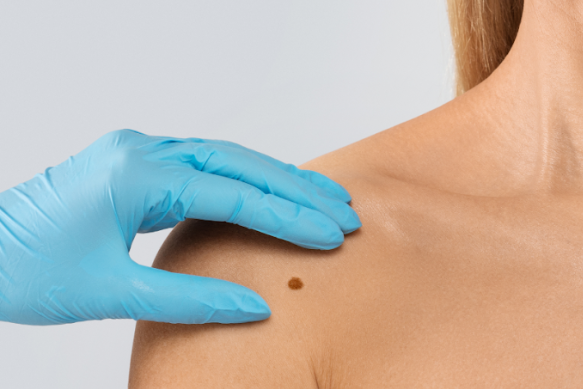
What is Mole Mapping?
Mole mapping is a screening technique that utilises advanced digital technology to systematically map and track moles on the body. This process involves capturing detailed images of moles across the skin surface, which are then analysed and compared over time to detect any changes or new developments. Mole mapping is particularly useful for identifying potential signs of skin cancer, such as malignant melanoma, at an early stage when treatment can be most effective.
How does Mole Mapping work?
Mole mapping is a comprehensive procedure that commences with an initial assessment of the skin and moles using tools like a dermoscope. Advanced digital cameras or specialised systems like Map My Mole, utilised at The Cosmetic Club, capture precise images of all moles, establishing a baseline for future comparisons. These digital images are stored and mapped, facilitating accurate comparisons during subsequent visits to detect any changes in mole characteristics. Dermatologists analyse these images, identifying suspicious moles for further evaluation and recommending a follow-up schedule for ongoing monitoring and early detection of skin cancer, such as malignant melanoma.
How often should i have my moles checked?
The frequency of mole checks depends on individual risk factors. For those with a higher risk, such as a history of skin cancer or numerous moles, checks may be recommended every three to six months. Others with lower risk may opt for annual checks or monitor changes themselves monthly. Regular checks are crucial to detect any suspicious changes early. Consult a dermatologist to determine the best checkup schedule based on your specific risk factors and skin health history.
Why are unusual moles photographed instead of removed?
Many of the moles we photograph are not necessarily suspicious for melanoma – however, they may have unusual features that defy some of the criteria established for typical moles. Mole mapping allows us to reduce unnecessary removals of benign moles and prevent melanoma by documenting change over time.
FAQs
What should I do to prepare for a Mole Mapping appointment?
Before your Mole Mapping appointment, it’s advisable to avoid applying any lotions or creams on your skin, as these can affect the quality of the images. Wear comfortable, loose-fitting clothing to make it easier to expose all areas of your skin. If you have any new or changing moles, make a note of them so you can discuss them during your appointment.
How long does a Mole Mapping session take?
A Mole Mapping session typically takes around 30 to 60 minutes, depending on the number of moles and areas of the body being examined. The process involves capturing detailed images of all moles and assessing them with specialised equipment to establish a baseline for future comparisons.
Will mole mapping detect all types of skin cancer?
Mole mapping is highly effective for detecting changes in moles that may indicate malignant melanoma or other skin cancers, particularly when monitored over time. However, it is not a substitute for a full skin examination. Regular follow-ups and additional diagnostic tests may be necessary for a comprehensive assessment of skin health.
What happens if a mole shows significant changes during a follow-up?
If a mole shows significant changes during a follow-up, your dermatologist may recommend further examination or a biopsy to determine if it is cancerous. The follow-up process helps to ensure that any potential issues are identified and addressed promptly, allowing for early intervention and treatment if necessary.